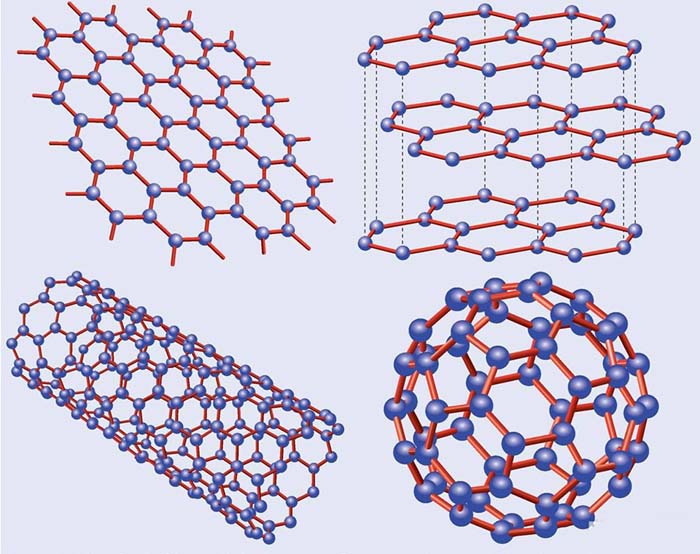Carbon nanomaterials Introduction
Carbon nanomaterials Introduction
For a long time, people only know that there are three carbon allotropes: diamond, graphite and amorphous carbon. However, in the past three decades, from the zero-dimensional fullerenes, one-dimensional carbon nanotubes, to two-dimensional graphene has been continuously discovered, new carbon nanomaterials continue to attract the attention of the world. Carbon nanomaterials can be classified into three categories according to the degree of nanoscale constraint on their spatial dimensions: zero-dimensional, one-dimensional and two-dimensional carbon nanomaterials.
0-dimensional nanomaterials refer to materials that are in the nanometer scale in three-dimensional space, such as nano-particles, atomic clusters and quantum dots. They are usually composed of a small number of atoms and molecules. There are many zero-dimensional carbon nano-materials, such as carbon black, nano-diamond, nano-fullerene C60, carbon-coated nano-metal particles.
As soon as the C60 was discovered, chemists began to explore the possibility of their application to the catalyst. At present, fullerenes and their derivatives in the field of catalytic materials mainly include the following three aspects:
(1) fullerenes directly as a catalyst;
(2) fullerenes and their derivatives as a homogeneous catalyst;
(3) Application of Fullerenes and their Derivatives in Heterogeneous Catalysts.
Carbon-coated nano-metal particles are a new type of zero-dimensional nano-carbon-metal composite. Due to the limitation of the carbon shell and the protective effect, the metal particles can be confined in a small space and the metal nanoparticles coated therein can be stably existed under the influence of the external environment. This new type of zero-dimensional carbon-metal nanomaterials has unique optoelectronic properties and has a very wide range of applications in medical, magnetic recording materials, electromagnetic shielding materials, lithium battery electrode materials and catalytic materials.
One-dimensional carbon nanomaterials means that electrons move freely in only one non-nanoscale direction and the motion is linear. Typical representatives of one-dimensional carbon materials are carbon nanotubes, carbon nanofibers and the like. The difference between the two can be based on the diameter of the material to distinguish, can also be based on the degree of graphitization of the material to be defined. According to the diameter of the material means that: the diameter D below 50nm, the internal hollow structure is usually referred to as carbon nanotubes, and the diameter in the range of 50-200nm, mostly by the multi-layer graphite sheet curled, with no obvious Hollow structures are often referred to as carbon nanofibers.
According to the degree of graphitization of the material, the definition refers to the graphitization is better, the orientation of the graphite sheet oriented parallel to the tube axis is called carbon nanotubes, while the degree of graphitization is low or no graphitization structure , The arrangement of the graphite sheets is disorganized, the material with hollow structure in the middle and even the multi-walled carbon nanotubes are all divided into carbon nanofibers. Of course, the distinction between carbon nanotubes and carbon nanofibers is not obvious in various documents.
In our opinion, regardless of the degree of graphitization of carbon nanomaterials, we distinguish between carbon nanotubes and carbon nanofibers based on the presence or absence of a hollow structure. That is, one-dimensional carbon nanomaterials defining a hollow structure are carbon nanotubes that have no hollow structure Or the hollow structure is not obvious one-dimensional carbon nanomaterials carbon nanofibers.
Two-dimensional carbon nanomaterials: Graphene is a representative of two-dimensional carbon nanomaterials. Two-dimensional functional materials represented by graphene have been very hot in recent years. This star material shows amazing unique properties in mechanics, electricity, heat and magnetism. Structurally, graphene is the basic unit that makes up other carbon materials: it warps up to zero-dimensional fullerenes, curls into one-dimensional carbon nanotubes, and stacks into three-dimensional graphite.
In summary, carbon nanomaterials have always been a hot topic in nanoscience and technology research and have made important research progress. Due to their unique structure and excellent physical and chemical properties, carbon nanomaterials are widely used in lithium-ion battery materials, optoelectronic materials , Catalyst carriers, chemical and biological sensors, hydrogen storage materials and supercapacitor materials and other aspects of concern.
China Hongwu Micro-Nano Technology Co., Ltd — the forerunner of industrialization of nano-carbon materials, is the first domestic manufacturer of carbon nanotubes and other nano-carbon materials for industrial production and application of the world’s leading quality, production of nano-carbon materials have been exported to All over the world, the response is good. Based on the national development strategy and modular management, Hongwu Nano adhere to market-oriented, technology-driven, to meet the reasonable demands of customers as its mission, and make unremitting efforts to enhance the strength of China’s manufacturing industry.
